実施日 : 2011年10月06日(木) - 07日(金)
Notice: San-in Region Press Tour (October 6-7, 2011)
投稿日 : 2013年08月22日
- Shimane: “The Land of the Gods,” Celebrating the 1300th Anniversary of the Compilation of Kojiki
- Tottori: Regional Revitalization Strategy, Taking Advantage of Forests and Water in Daisen
Shimane Prefecture: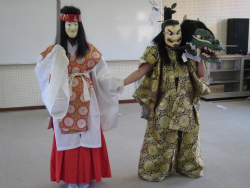 The year 2012 will be the 1300th anniversary of the compilation of Kojiki, the “record of ancient matters,” the oldest extant chronicle of Japan, a collection of myths. As one third of the myths in the Kojiki are of the Izumo area, Shimane Prefecture is known as the “homeland of myths” and it is a place where the fine old Japanese original landscape remains.
The year 2012 will be the 1300th anniversary of the compilation of Kojiki, the “record of ancient matters,” the oldest extant chronicle of Japan, a collection of myths. As one third of the myths in the Kojiki are of the Izumo area, Shimane Prefecture is known as the “homeland of myths” and it is a place where the fine old Japanese original landscape remains.
The spiritual center of this area is Izumo-taisha Grand Shrine, which is said to have a history of several thousand years. The shrine deity is known as the god of en-musubi (affinity), and currently it attracts many young women worshipers as a hotspot for match-making. The shrine is in the middle of a five-year (2008-2013) renovation called “Heisei-no-daisengu,” the first in 60 years. The thatching of the big roof of Honden, the main hall, is now being replaced, and craftsmen with inherited traditional skills are giving full play to their abilities in this once-in-a-lifetime project.
Shimane Prefecture, also refered to as “The Land of the Gods,” is one of the most popular places in Japan for Kagura (ancient music and dancing), in which people perform as gods. While the collapse of regional communities is a matter of concern these days, in Shimane the traditional culture is being steadily passed on to the children. In the current “muen-shakai,” or unconnected society, the Great East Japan Earthquake was a reminder of the importance of “kizuna (bonds)” and “en (connection)” of people.
The tour will touch upon the fundamental spirit and feeling of the Japanese people and will also focus on the people who are concerned with passing on traditional skills and culture.
Tottori Prefecture: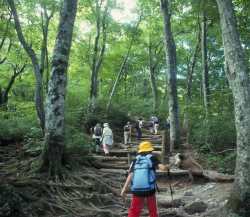 This year is the United Nations International Year of Forests. How to protect forests from the deforestation and global warming occuring around the world, and the sustainable management and utilization of forests, are challenging issues.
This year is the United Nations International Year of Forests. How to protect forests from the deforestation and global warming occuring around the world, and the sustainable management and utilization of forests, are challenging issues.
Daisen is located in the western part of Tottori Prefecture, where 70% of the land area is forest. It has been worshiped as a “divine mountain” from ancient times and is now designated as a national park. Recently, with the growth of environmental awareness and the social need for psycological healing, eco tours covering Daisen’s nature and “spiritual spots” are becoming popular.
Big forests also produce abundant and clean water, which is benefiting the region as a precious natural resouce and leading to the vitalization of the area. For example, Yonago City, a major commercial city in west Tottori, uses underground water from Daisen as tap-water. It has been selected as one of the best 32 cities by the “Tasty Water Research Committee” of the Ministry of Labor, Health and Welfare. Some companies have decided to move to Yonago for the sake of this plentiful pure underground water. At the foot of Daisen, major beverage comapanies have established factories and the “water of Daisen” is now sold all over the nation, and business is flourishing.
Shimane Prefecture is the least populated prefecture in Japan, with only 590,000 inhabitants. Some aging and depopulated mountainous regions in the prefecture are trying to utilize the rich water resources and natural advantages for regional revitalization and the employment of elderly people. The press tour will experience the precious nature of Daisen and will also cover the regional revitalization strategy that takes advantage of the rich forests and water.
Presentations
<Shimane Prefecture>
1.“SHIMANE - The Land of the Gods” Project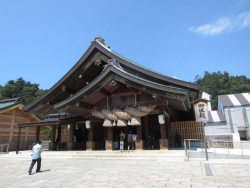 The year 2012 will be the 1300th anniversary of the compilation of “Kojiki,” the oldest chronicle of Japan, that describes how the country was created. It has been decided that the “Japan Myth Expo in Shimane (Shinwa-haku Shimane)” will be held from July 21 to November 11 next year mainly in the area surrounding Izumo-taisha. Taking this opportunity, Shimane Prefecture is promoting a project “SHIMANE - The Land of the Gods” to showcase the magnificent world of myths and the attractions of Shimane. The project suggests, “What is described in Kojiki is the beginning of this country and “en” or human connections. Now is the time for us to go back to the starting point and rethink human ties.” The tour will be given a briefing by prefectural officials on the background and target of the project, and also an interview with Governor Zenbee Mizoguchi. You will also have a chance to visit Shimane Museum of Ancient Izumo to have a glimpse of the history of Izumo.
The year 2012 will be the 1300th anniversary of the compilation of “Kojiki,” the oldest chronicle of Japan, that describes how the country was created. It has been decided that the “Japan Myth Expo in Shimane (Shinwa-haku Shimane)” will be held from July 21 to November 11 next year mainly in the area surrounding Izumo-taisha. Taking this opportunity, Shimane Prefecture is promoting a project “SHIMANE - The Land of the Gods” to showcase the magnificent world of myths and the attractions of Shimane. The project suggests, “What is described in Kojiki is the beginning of this country and “en” or human connections. Now is the time for us to go back to the starting point and rethink human ties.” The tour will be given a briefing by prefectural officials on the background and target of the project, and also an interview with Governor Zenbee Mizoguchi. You will also have a chance to visit Shimane Museum of Ancient Izumo to have a glimpse of the history of Izumo.
2.Izumo-taisha
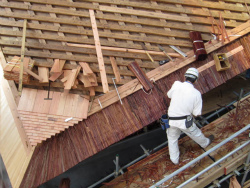 Izumo-taisha is a symbol of “The Land of the Gods,” and the “Heisei-no-daisengu” renovation, the first in 60 years, is now under way. The establishment of this old shrine is described in Kojiki, and the shrine deity is now well-known as a god of affinity and happiness. These days the shrine attracts many young women for its charm as a “power spot” or “spiritual spot.” The Honden, the main hall which enshrines Okuninushi-no-okami, has a typical Taisha-zukuri architectural style, and is designated as a national treasure. The height of the Honden is 24 meters, taller than any other shrine structure in Japan. In the tenth month of the lunar calendar, myriads of gods are said to gather in Izumo from all over the country, making the month “kannazuki” or “god absent” month in the rest of Japan. In Izumo, however, the month is called “kamiarizuki” or “god present” month, and Shinto rituals welcoming the deities are held (in early November this year).
Izumo-taisha is a symbol of “The Land of the Gods,” and the “Heisei-no-daisengu” renovation, the first in 60 years, is now under way. The establishment of this old shrine is described in Kojiki, and the shrine deity is now well-known as a god of affinity and happiness. These days the shrine attracts many young women for its charm as a “power spot” or “spiritual spot.” The Honden, the main hall which enshrines Okuninushi-no-okami, has a typical Taisha-zukuri architectural style, and is designated as a national treasure. The height of the Honden is 24 meters, taller than any other shrine structure in Japan. In the tenth month of the lunar calendar, myriads of gods are said to gather in Izumo from all over the country, making the month “kannazuki” or “god absent” month in the rest of Japan. In Izumo, however, the month is called “kamiarizuki” or “god present” month, and Shinto rituals welcoming the deities are held (in early November this year).
A senior priest of the shrine will explain about the history and status of the shrine, and the current Daisengu, and show you the Kariden (temporary hall), the site at which the ancient shrine was excavated, and the Honden (main hall). In the Honden, the thatch replacement work is under way, and craftsmen from various parts of western Japan are nailing layers of cypress bark to the roof using bamboo pegs. You will have a chance to interview a chief thatcher on the work and learn how the traditional skills are being passed on.
3.Shinmon-dori Yomigaeri-no-kai
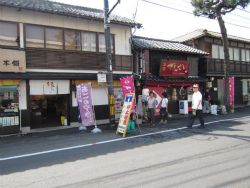 Shinmon-dori is a street located in front of the main gate of Izumo-taisha, and has long been catering to the needs of pilgrims and visitors. However, like other shopping streets in local cities, vacant stores started to increase in the 1980s and the street lost its liveliness. Mr. Mitsunori Tadano from Kanagawa Prefecture worked for a beverage company in Tokyo for 16 years. Since his father was from Shimane Prefecture, he applied for the “Challenge Shop Project” of Izumo City, thinking of making a fresh start at a place of match-making. In October 2007, he opened a little shop named “Taisha Monzen Izumoya,” selling dumplings and sweet red bean soups, using Shimane’s local produce. In 2008, he established “Shinmon-dori Yomigaeri-no-kai (Association to Revive Shinmon-dori)” with local shop-owners. So far 16 new shops have opened and various events are successfully revitalizing the area. The tour will visit Shinmon-dori at lunch time and cover their efforts to restore the lively shopping street.
Shinmon-dori is a street located in front of the main gate of Izumo-taisha, and has long been catering to the needs of pilgrims and visitors. However, like other shopping streets in local cities, vacant stores started to increase in the 1980s and the street lost its liveliness. Mr. Mitsunori Tadano from Kanagawa Prefecture worked for a beverage company in Tokyo for 16 years. Since his father was from Shimane Prefecture, he applied for the “Challenge Shop Project” of Izumo City, thinking of making a fresh start at a place of match-making. In October 2007, he opened a little shop named “Taisha Monzen Izumoya,” selling dumplings and sweet red bean soups, using Shimane’s local produce. In 2008, he established “Shinmon-dori Yomigaeri-no-kai (Association to Revive Shinmon-dori)” with local shop-owners. So far 16 new shops have opened and various events are successfully revitalizing the area. The tour will visit Shinmon-dori at lunch time and cover their efforts to restore the lively shopping street.
4.Children’s Kagura (Kagura Club of Ushio Junior High School)
 The myth of the Yamata-no-orochi, a legendary 8-headed and 8-tailed dragon, originates in Unnan City. It is said that the Suga Jinja Shrine, Unnan City, is where Susanoo set up his new home to live with his wife Inatahime after defeating Yamatano Orochi. This became the first shrine in Japan. So Suga Jinja is also called“Nihon-hatsu-no-miya (Japan's first shrine).” Moreover, the area is said to hold the origins of Japanese poetry, because the poems said to have been composed by Susanoo at that time are considered to be the first waka, typical Japanese poems. The word “Izumo” itself was first used in one of his poems.
The myth of the Yamata-no-orochi, a legendary 8-headed and 8-tailed dragon, originates in Unnan City. It is said that the Suga Jinja Shrine, Unnan City, is where Susanoo set up his new home to live with his wife Inatahime after defeating Yamatano Orochi. This became the first shrine in Japan. So Suga Jinja is also called“Nihon-hatsu-no-miya (Japan's first shrine).” Moreover, the area is said to hold the origins of Japanese poetry, because the poems said to have been composed by Susanoo at that time are considered to be the first waka, typical Japanese poems. The word “Izumo” itself was first used in one of his poems.
Kagura, a traditional performing art featuring stories originating from the myths of Kojiki, is widely performed in Shimane Prefecture. There are over 100 performing groups, mainly in the Iwami region of west Shimane, making the prefecture the center of Kagura in Japan. Strong human ties in the regional community help this traditional art to be steadily passed on to the next generation, resulting in many performances by children. Unnan Municipal Ushio Junior High School is, however, the only junior high school in Shimane Prefecture to have a Kagura club. There are altogether 50 students in this small-scale school, located in a mountainous area, and 15 of them are in the Kagura club. The club performs Kagura more than ten times a year. The tour will cover the Kagura Club of Ushio Junior High School at a rehearsal and interview students and a teacher at the “Kagura-no-yado,” in a renovated historical residence.
<Tottori Prefecture>
1.Fukuoka-ku, Hoki-cho
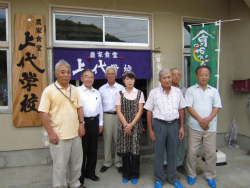 Fukuoka-ku is located in the southern part of Hoki-cho at the foot of Daisen. Only 180 people live in this mountainous community and 47% of the population are aged 65 or older. Fukuoka-ku was established in January 2009 by the consolidation of five regional communities to maintain community functions and revitalize the region. Wishing to make the region more lively in spite of the aging trend and depopulation, the local people have discussed regional revitalization measures, taking advantage of the rich water resources and agricultural products. In May 2009, nine local residents established Kamidai Corporation, and opened a farm restaurant “Kachan-soba (Mom’s Buckwheat Noodles)” the following month, hiring seven elderly women, over 70 years old on average, as soba-makers. In July, Hoki-cho was designated a special economic zone for doburoku (unrefined sake) production, the first in Tottori Prefecture. In January 2010, they started producing doburoku in a brewery established at a former primary school ground. Kachan-soba originally opened only at weekends, but as it has become very popular attracting return visitors from other prefectures, they started to open on weekdays as well. As for the doburoku, the initial 2,000 liters of “Genryu Doburoku Kamidai” were sold out, and in the last year, the sales volume increased to 3,500 liters as the market expanded. The tour will cover their efforts to revitalize the community by hiring elderly people and increasing the number of visitors, by visiting Kachan-soba and the doburoku brewery, and interviewing President Keisei Sumida of Kamidai Corporation.
Fukuoka-ku is located in the southern part of Hoki-cho at the foot of Daisen. Only 180 people live in this mountainous community and 47% of the population are aged 65 or older. Fukuoka-ku was established in January 2009 by the consolidation of five regional communities to maintain community functions and revitalize the region. Wishing to make the region more lively in spite of the aging trend and depopulation, the local people have discussed regional revitalization measures, taking advantage of the rich water resources and agricultural products. In May 2009, nine local residents established Kamidai Corporation, and opened a farm restaurant “Kachan-soba (Mom’s Buckwheat Noodles)” the following month, hiring seven elderly women, over 70 years old on average, as soba-makers. In July, Hoki-cho was designated a special economic zone for doburoku (unrefined sake) production, the first in Tottori Prefecture. In January 2010, they started producing doburoku in a brewery established at a former primary school ground. Kachan-soba originally opened only at weekends, but as it has become very popular attracting return visitors from other prefectures, they started to open on weekdays as well. As for the doburoku, the initial 2,000 liters of “Genryu Doburoku Kamidai” were sold out, and in the last year, the sales volume increased to 3,500 liters as the market expanded. The tour will cover their efforts to revitalize the community by hiring elderly people and increasing the number of visitors, by visiting Kachan-soba and the doburoku brewery, and interviewing President Keisei Sumida of Kamidai Corporation.
2.Water in Daisen
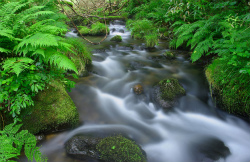 The secret of the rich natural water in Tottori lies in the beech forest in Daisen, the largest in western Japan. Daisen had been protected as a “divine mountain” in the Jomon and Yayoi periods (14,000BC-300AD), and from the Nara period (710-784), entry to the mountain was strictly limited as it was regarded as the sacred ground of mountain worship. As a result, the rich beech forest and plentiful underground clean natural water have been preserved. Residents at the foot of the mountain, mainly in Tottori Prefecture, have used the water for drinking and agriculture from ancient times. Even now, the tap water in the area at the foot of the mountain is natural Daisen water, which is also used for agriculture and industries. The water full of minerals and iron flows into the Sea of Japan, bringing abundant marine products. Mr. Takao Ishimura, President of NPO Daisen Nakaumi Tourist Organization (Daisen Kingdom) and an expert on this region, will give a briefing on Daisen’s history, culture, and nature, featuring the “water.”
The secret of the rich natural water in Tottori lies in the beech forest in Daisen, the largest in western Japan. Daisen had been protected as a “divine mountain” in the Jomon and Yayoi periods (14,000BC-300AD), and from the Nara period (710-784), entry to the mountain was strictly limited as it was regarded as the sacred ground of mountain worship. As a result, the rich beech forest and plentiful underground clean natural water have been preserved. Residents at the foot of the mountain, mainly in Tottori Prefecture, have used the water for drinking and agriculture from ancient times. Even now, the tap water in the area at the foot of the mountain is natural Daisen water, which is also used for agriculture and industries. The water full of minerals and iron flows into the Sea of Japan, bringing abundant marine products. Mr. Takao Ishimura, President of NPO Daisen Nakaumi Tourist Organization (Daisen Kingdom) and an expert on this region, will give a briefing on Daisen’s history, culture, and nature, featuring the “water.”
3.Daisen Eco Tour
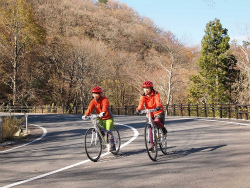 Daisen has been worshiped as “a mountain where a god resides,” and is popular as a training site for “Shugendo,” or mountain asceticism, as well as mountain worship. The impressive natural of Daisen with its abundant water, mysterious atmosphere features and power arising from the trees and rocks, are now attracting people in modern society who are searching for psychological healing. The Daisen, Nakaumi Eco Tourism Association is working on the promotion of distinctive eco tours, featuring Daisen Oki National Park and surrounding areas, and Nakaumi, a Ramsar Convention site. The tour will learn about their efforts to achieve a sustainable region where nature, history, tradition and culture are well preserved, at the same time producing new tourist attractions and promoting economic activities. You will also try part of the eco tours (beech forest walking and downhill cycling) and feel the charm of nature.
Daisen has been worshiped as “a mountain where a god resides,” and is popular as a training site for “Shugendo,” or mountain asceticism, as well as mountain worship. The impressive natural of Daisen with its abundant water, mysterious atmosphere features and power arising from the trees and rocks, are now attracting people in modern society who are searching for psychological healing. The Daisen, Nakaumi Eco Tourism Association is working on the promotion of distinctive eco tours, featuring Daisen Oki National Park and surrounding areas, and Nakaumi, a Ramsar Convention site. The tour will learn about their efforts to achieve a sustainable region where nature, history, tradition and culture are well preserved, at the same time producing new tourist attractions and promoting economic activities. You will also try part of the eco tours (beech forest walking and downhill cycling) and feel the charm of nature.
*Foreign Press Center/Japan and San-in International Tourism Conference have co-organized this press tour. Tour participants bear part of the cost, but the purpose of the tour is not profit-making.
Tour Itinerary and Application Details
1. Tour itinerary (tentative):
Day 1: Thursday, October 6 (Shimane Prefecture)
07:25 Leave Haneda Airport by JAL Flight 1663
08:55 Arrive at Izumo Airport
09:45-10:40 Briefing on “SHIMANE - The Land of the Gods” Project
and Visit to Shimane Museum of Ancient Izumo
11:00-12:20 Izumo-taisha
12:30-13:30 Lunch and tour of Shinmon-dori street
14:30-15:40 Children’s Kagura performance
16:30-17:00 Press Conference by Governor of Shimane Prefecture
18:30 Arrive at Hotel
Day 2: Friday, October 7 (Tottori Prefecture)
09:00 Leave hotel
09:45-12:00 Fukuoka-ku, Hoki-cho (Includes lunch)
13:00-14:00 Briefing on Mt. Daisen’s Water
14:15-16:15 Eco tours
19:00 Leave Izumo Airport by JAL Flight 1672
20:20 Arrive at Haneda Airport
2. Qualification:
Participants must have Gaimusho Foreign Press Registration Cards
3. Cost:
13,000 per person including transportation, meals, and accommodation
*FPCJ will inform the participants of payment methods, cancellation fee etc. later on.
4. Participants:
Limited to the first 10 applicants on a first-come-first-served basis. (Only one reporter and one photographer from each organization, but two participants from each TV team will be acceptable.) If the number of applicants exceeds 10, an upper limit may be set on the number of participants from each country.
5. FPCJ Contact:
Mr. Yamaguchi / Mr. Yano (Tel: 03-3501-5070, 3405)
6. Remarks:
1) There are some restrictions on photographing and filming in the press tour. Please follow the instructions of the officials on duty.
2) FPCJ and San-in International Tourism Conference will not be liable for any inconvenience, trouble or accident that might occur in the course of the tour.


